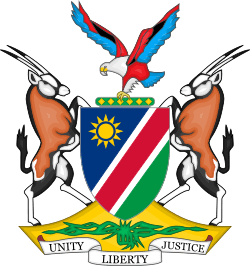Namibia–South Africa relations
Namibia–South Africa relations refers to the current and historical relationship between Namibia and South Africa. South Africa captured the area now known as Namibia from Germany during World War I and occupied it until 1990, when it gained independence. During those 75 years, thousands of South Africans settled in Namibia and South Africa treated the area as an internal province rather than occupied foreign entity, imposing apartheid laws in Namibia as it did in South Africa.[1]
Namibia |
South Africa |
|---|---|
Both nations are members of the African Union, Commonwealth of Nations, Southern African Development Community and the United Nations.
South-West Africa and Namibian independence (1915-1990)
During World War I, South Africa captured and occupied what was then German South-West Africa beginning in 1915. After the war, the League of Nations removed overseas territories from a defeated Germany and they mandated the territory to South Africa as a trusteeship, however, South Africa refused to place South-West Africa under trusteeship. Instead, South Africa proposed that it be allowed to annex South-West Africa; a proposal rejected by the United Nations General Assembly. As a result, South-West Africa was administered directly by South African administrators in Pretoria as a province and many white South African settlers came to the country. Walvis Bay was officially declared part of South Africa. South African Apartheid was also introduced into the country and led to the creation of tribal homelands for black inhabitants of the country.
In August 1966, the South African Border War began between the South West Africa People's Organization (SWAPO) and the South African Defence Force. SWAPO's goal was to obtain independence from South African dominance. SWAPO had majority international support and received military assistance from neighboring independent nations, Angola's People's Armed Forces for the Liberation of Angola (FAPLA) and Cuba. In June 1968, the UN General Assembly adopted a resolution proclaiming that, in accordance with the desires of its people. The United Nations Security Council Resolution 269, adopted in August 1969, declared South Africa's continued occupation of Namibia illegal. The war lasted until March 1990 with South-West Africa winning its independence and the country was renamed Namibia.
Post-Namibian independence (1990-)
In 1994, apartheid ended in South Africa and Nelson Mandela was elected President of the country. Since then, relations between Namibia and South Africa have remained close. There have been numerous visits between leaders of both nations and several agreements have been signed. The economy of Namibia is also closely linked to South Africa in terms of trade and South African companies have a large number of investments in the key industries in Namibia such as mining, retail, banking and insurance.[2] Namibia contributes greatly to the growth and development of the South African tourism industry. Namibia ranked as South Africa’s 9th largest source of tourism.[2]
Resident diplomatic missions
References
- Schenoni, Luis (2017) "Subsystemic Unipolarities?"in Strategic Analysis, 41(1): 74-86
- Bilateral relations between South Africa and Namibia
- Namibian high commission in Pretoria
- South African high commission in Windhoek
Further reading
- A New Small State with a Powerful Neighbour: Namibia/South Africa Relations since Independence by Graham Evans, The Journal of Modern African Studies, March 1993
External links
- SA, Namibia push corridor development SouthAfrica.info, 8 November 2010
